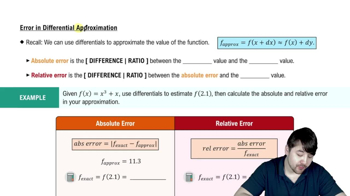Table of contents
- 0. Functions7h 52m
- Introduction to Functions16m
- Piecewise Functions10m
- Properties of Functions9m
- Common Functions1h 8m
- Transformations5m
- Combining Functions27m
- Exponent rules32m
- Exponential Functions28m
- Logarithmic Functions24m
- Properties of Logarithms34m
- Exponential & Logarithmic Equations35m
- Introduction to Trigonometric Functions38m
- Graphs of Trigonometric Functions44m
- Trigonometric Identities47m
- Inverse Trigonometric Functions48m
- 1. Limits and Continuity2h 2m
- 2. Intro to Derivatives1h 33m
- 3. Techniques of Differentiation3h 18m
- 4. Applications of Derivatives2h 38m
- 5. Graphical Applications of Derivatives6h 2m
- 6. Derivatives of Inverse, Exponential, & Logarithmic Functions2h 37m
- 7. Antiderivatives & Indefinite Integrals1h 26m
- 8. Definite Integrals4h 44m
- 9. Graphical Applications of Integrals2h 27m
- 10. Physics Applications of Integrals 2h 22m
4. Applications of Derivatives
Differentials
Problem 4.8.49
Textbook Question
{Use of Tech} Fixed points An important question about many functions concerns the existence and location of fixed points. A fixed point of f is a value of x that satisfies the equation f(x) = x; it corresponds to a point at which the graph of f intersects the line y = x. Find all the fixed points of the following functions. Use preliminary analysis and graphing to determine good initial approximations.
f(x) = cos x
 Verified step by step guidance
Verified step by step guidance1
Understand the concept of a fixed point: A fixed point of a function f(x) is a value x such that f(x) = x. For the function f(x) = cos(x), we need to find x such that cos(x) = x.
Graph the function y = cos(x) and the line y = x on the same set of axes. The points where these two graphs intersect are the fixed points of the function.
Perform a preliminary analysis by considering the behavior of the cosine function. Note that cos(x) oscillates between -1 and 1, while the line y = x is a straight line with a slope of 1. This suggests that fixed points, if they exist, will be within the interval [-1, 1].
Use a numerical method, such as the fixed-point iteration method, to approximate the fixed points. Start with an initial guess within the interval [-1, 1], such as x_0 = 0.5, and iterate using the formula x_{n+1} = cos(x_n) until the values converge to a stable point.
Verify the solution by checking if the value obtained satisfies the equation cos(x) = x to a desired level of accuracy. This can be done by substituting the value back into the equation and ensuring the left and right sides are approximately equal.
 Verified video answer for a similar problem:
Verified video answer for a similar problem:This video solution was recommended by our tutors as helpful for the problem above
Video duration:
2mPlay a video:
Was this helpful?
Key Concepts
Here are the essential concepts you must grasp in order to answer the question correctly.
Fixed Points
A fixed point of a function f is a value x such that f(x) = x. This means that when the function is applied to this value, it returns the same value. Graphically, fixed points are where the graph of the function intersects the line y = x. Identifying fixed points is crucial in various applications, including iterative methods and stability analysis.
Recommended video:

Critical Points
Graphing Functions
Graphing functions involves plotting the values of a function on a coordinate system to visualize its behavior. This technique helps in identifying key features such as intercepts, maxima, minima, and fixed points. For the function f(x) = cos x, graphing allows us to see where the curve intersects the line y = x, providing insights into the location of fixed points.
Recommended video:

Graph of Sine and Cosine Function
Preliminary Analysis
Preliminary analysis refers to the initial examination of a function to gather information about its behavior before performing detailed calculations. This can include evaluating the function at specific points, analyzing its derivatives, and understanding its general shape. For f(x) = cos x, preliminary analysis can help estimate where fixed points might be located, guiding further investigation.
Recommended video:

Derivatives Applied To Velocity







